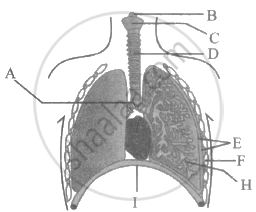Advertisements
Advertisements
प्रश्न
What are the major transport mechanisms for CO2? Explain.
उत्तर १
Nearly 20–25 percent of CO2 is transported by haemoglobin in RBCs; 70 percent of it is carried as a bicarbonate ion in plasma; and about 7 percent of CO2 is carried in a dissolved state through plasma. CO2 is carried by haemoglobin as carbamino-haemoglobin. This binding is related to the partial pressure of CO2.
उत्तर २
Transportation of carbon dioxide by blood: Carbon dioxide produced by the oxidation of food substances stored in the tissues goes into the blood capillaries by diffusion. Its transportation through blood capillaries to the respiratory organs takes place in the following three ways:
(1) Through plasma:
About 7% of CO2 is carried in a dissolved state through plasma. Carbon dioxide combines with water and forms carbonic acid.
(2) Through sodium bicarbonate:
About 70% of carbon dioxide is transported as sodium bicarbonate. As CO2 diffuses into the blood plasma, a large part of it combines with water to form carbonic acid in the presence of the enzyme carbonic anhydrase. Carbonic anhydrase is a zinc enzyme that speeds up the formation of carbonic acid. This carbonic acid dissociates into bicarbonate (HCO3–) and hydrogen ions (H+).
\[\ce{CO2 + H2O->[\text{Carbonic acid}][\text{enzyme}]H2CO3->H+ + HCO3^-}\]
Since the process of forming carbonic acid is slow, only a small amount of carbon dioxide is carried this way.
In plasma, the carbonic anhydrase enzyme is absent; Therefore, bicarbonate is produced in less quantity in plasma. The bicarbonate ion `("HCO"_3^-)` reacts with the potassium ion (K+) of red blood cells and the sodium ion (Na+) of plasma to form potassium and sodium bicarbonate, respectively.
plasma - \[\ce{HCO_3^- + Na+->\underset{\text{sodium bicarbonate}}{NaHCO3}}\]
In red blood cells - \[\ce{HCO3^- + K+ ->\underset{\text{potassium bicarbonate}}{KHCO3}}\]
Chloride shift or Hamburger phenomenon: To maintain normal pH and electrical neutrality, as much bicarbonate ions come into the plasma from the blood corpuscles, the same number of chloride ions (Cl–) go into the blood corpuscles to replenish it. As a result of this process, there is accumulation of bicarbonate in plasma and chloride ions in red blood cells. This action is called chloride shift. At the respiratory level the processes occur in the opposite direction so that CO2 is released into the atmosphere
(3) Carboxyhemoglobin:
About 23% of carbon dioxide combines with the haemoglobin of red blood cells to form a temporary compound.
Haemoglobin + CO2 → Carboxyhemoglobin
Blood containing substances like bicarbonates of sodium and potassium, carboxyhemoglobin, etc. is impure. This blood reaches the heart through veins from the tissues and organs. This blood from the heart goes to the lungs through the pulmonary arteries to be purified. Due to the high amount of oxygen in the lungs, haemoglobin in the blood combines with oxygen to form oxyhaemoglobin. Oxyhaemoglobin is more acidic than haemoglobin. Due to oxyhemoglobin being acidic, carbonates and carbonic acid disintegrate on the respiratory surface.
- \[\ce{2NaHCO3->[\text{oxyhemoglobin}][\text{acidity}]Na2CO3 + H2O + CO2↑}\]
- \[\ce{2KHCO3->[\text{oxyhemoglobin}][\text{ acidity}]K2CO3 + H2O + CO2↑}\]
- \[\ce{H2CO3->H2O + CO2↑}\]
- carboxyhaemoglobin → haemoglobin + CO2 ↑
Temporary compounds formed in the form of carboxyhemoglobin and plasma proteins also combine with oxygen and release carbon dioxide.
APPEARS IN
संबंधित प्रश्न
What will be the pO2 and pCO2 in the atmospheric air compared to those in the alveolar air?
Choose the WRONG statement.
Select the option with correct identification
CO2 dissociates from carbaminohaemoglobin when ______.
A major percentage (97%) of O2 is transported by RBCs in the blood. How does the remaining percentage (3%) of O2 transported?
State the different modes of CO2 transport in blood.
